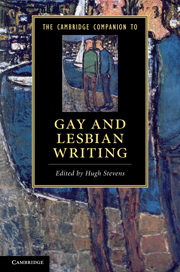Book contents
- Frontmatter
- Homosexuality and literature: an introduction
- Part I Repression and Legitimation
- Part II Affiliations
- Part III Literary Traditions
- 10 Encountering the past in recent lesbian and gay fiction
- 11 Queer cross-gender collaboration
- 12 Naming the unnameable: lesbian and gay love poetry
- 13 The queer writer in New York
- Guide to further reading
- Index
13 - The queer writer in New York
from Part III - Literary Traditions
Published online by Cambridge University Press: 28 January 2011
- Frontmatter
- Homosexuality and literature: an introduction
- Part I Repression and Legitimation
- Part II Affiliations
- Part III Literary Traditions
- 10 Encountering the past in recent lesbian and gay fiction
- 11 Queer cross-gender collaboration
- 12 Naming the unnameable: lesbian and gay love poetry
- 13 The queer writer in New York
- Guide to further reading
- Index
Summary
'Are we talking about literally New York or some kind of imagined scene?' Eileen Myles asks Dennis Cooper, even though she knows that the two cannot be separated, for what makes New York so powerful a place for gay and lesbian writers is that the 'literal' city can sustain and inspire so many imagined ones. People find in New York what they desire to imagine even as they imagine what they desire. This multiplicity and diversity of New Yorks is the starting point for both Edmund White's guide to gay life in the city in States of Desire (1980) and Samuel R. Delany's spirited defence in Times Square Red, Times Square Blue (1999). But to understand some of the power of New York as a place of and for the imagination, one must look at its physical design. By New York, people mean Manhattan and not the outer boroughs which along with Manhattan make up the actual jurisdiction. Unlike London, Paris, Rome or Moscow, which are all transected by rivers, Manhattan is an island surrounded by them. According to Geology of the City of New York (1909), Manhattan is a thirteen-mile-long outcrop of gneisses, granites, limestone and schist only superficially covered by drifts of river muds and sands. In the thirties Carl Van Vechten wrote that in New York no one can escape the sounds of blasting, 'which reminds one that Manhattan, like the Church of Rome, is built on solid rock'.
- Type
- Chapter
- Information
- The Cambridge Companion to Gay and Lesbian Writing , pp. 218 - 234Publisher: Cambridge University PressPrint publication year: 2010

